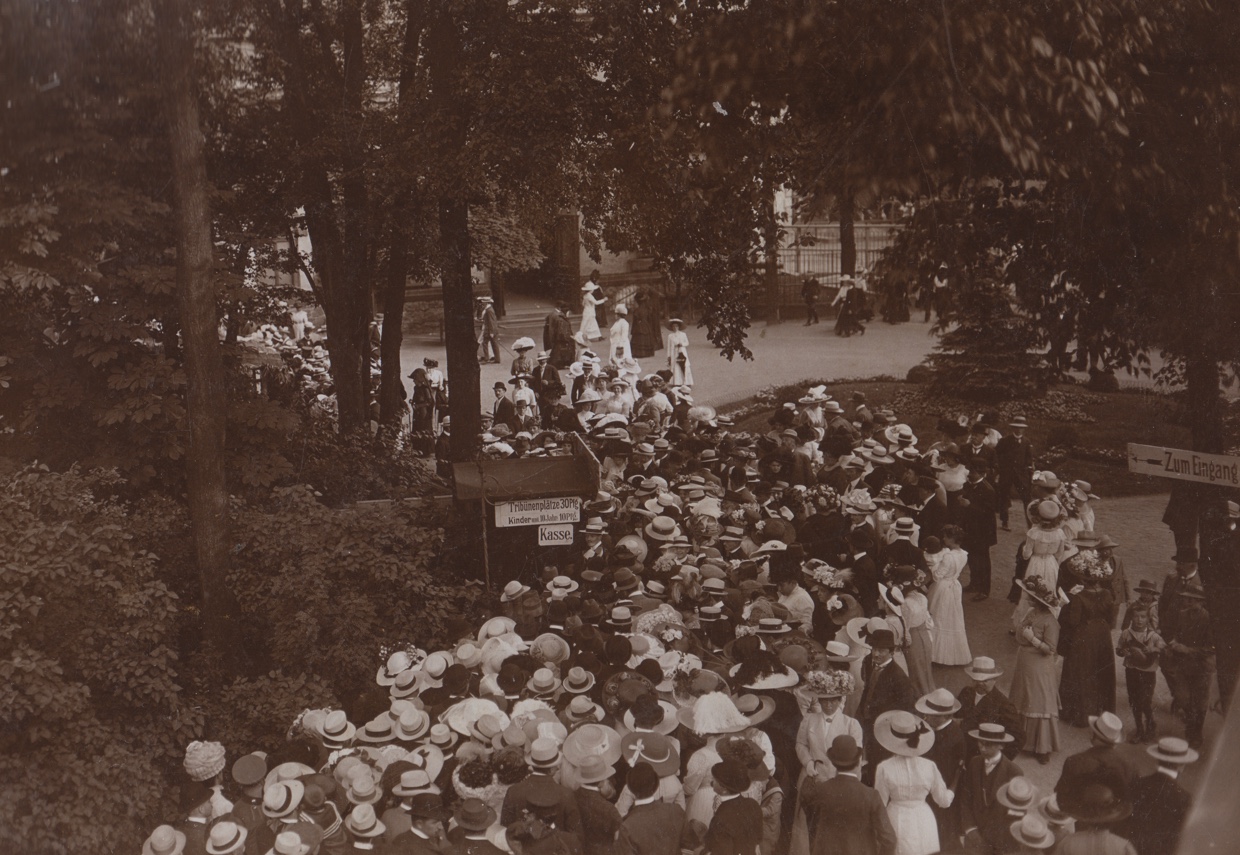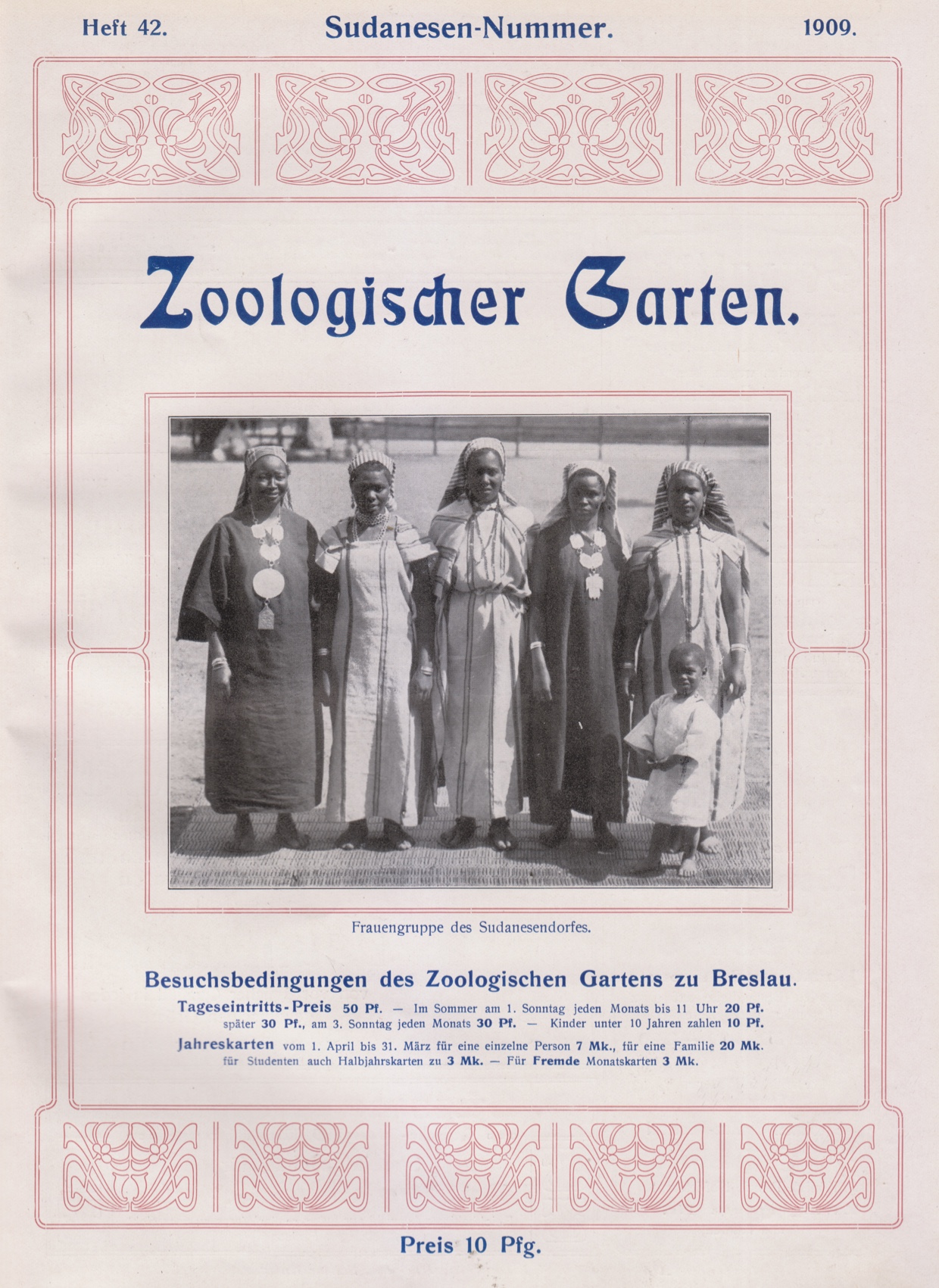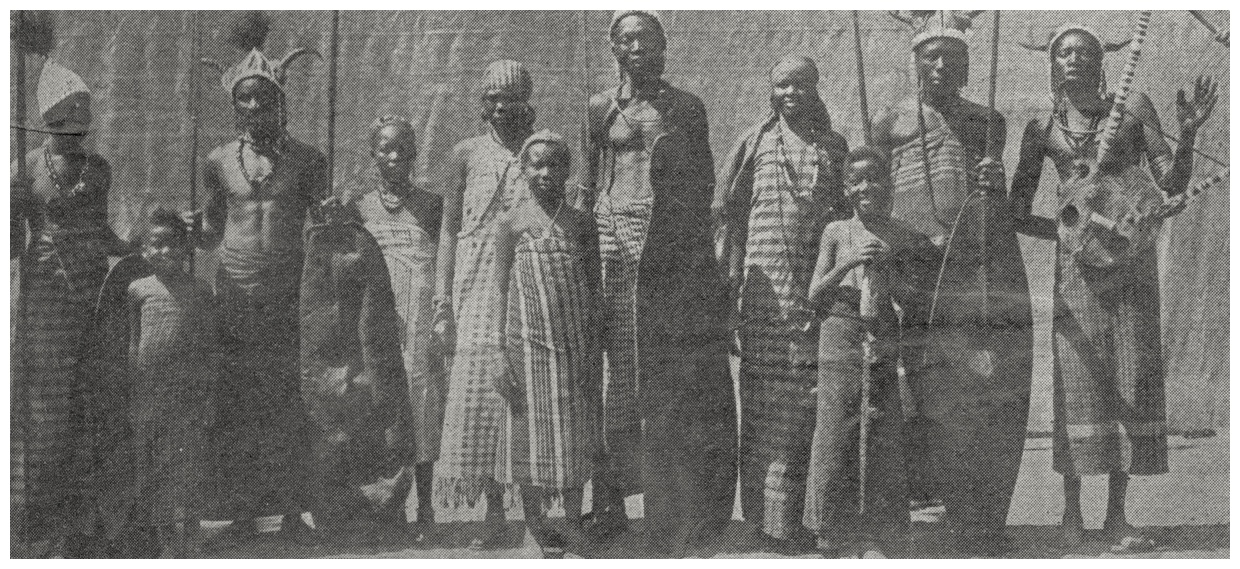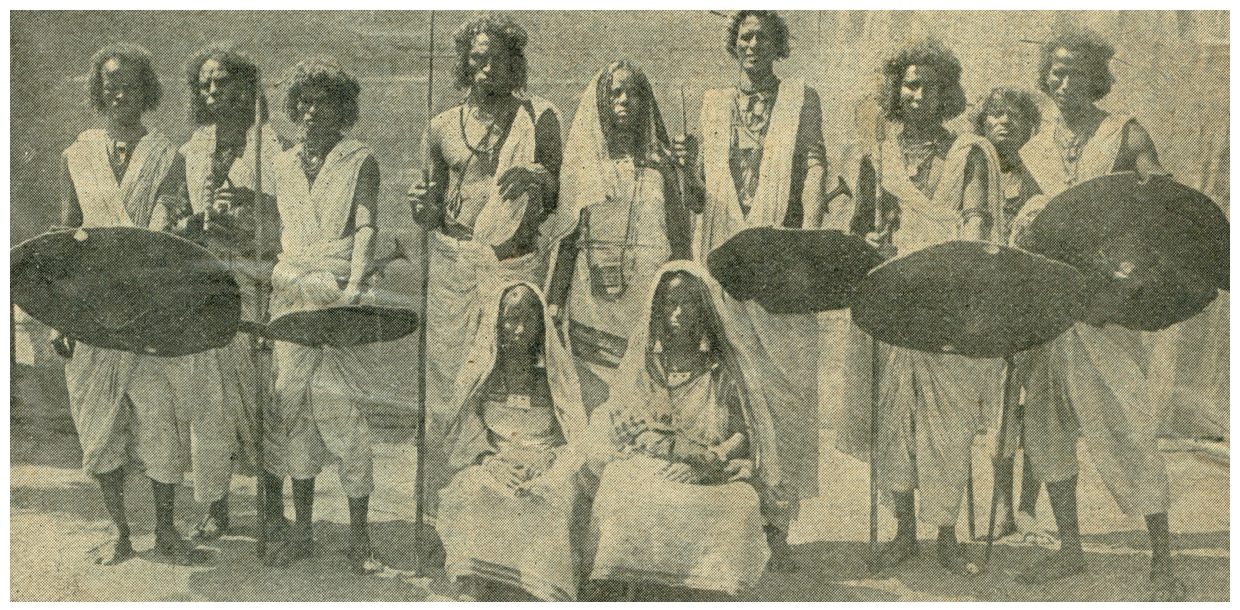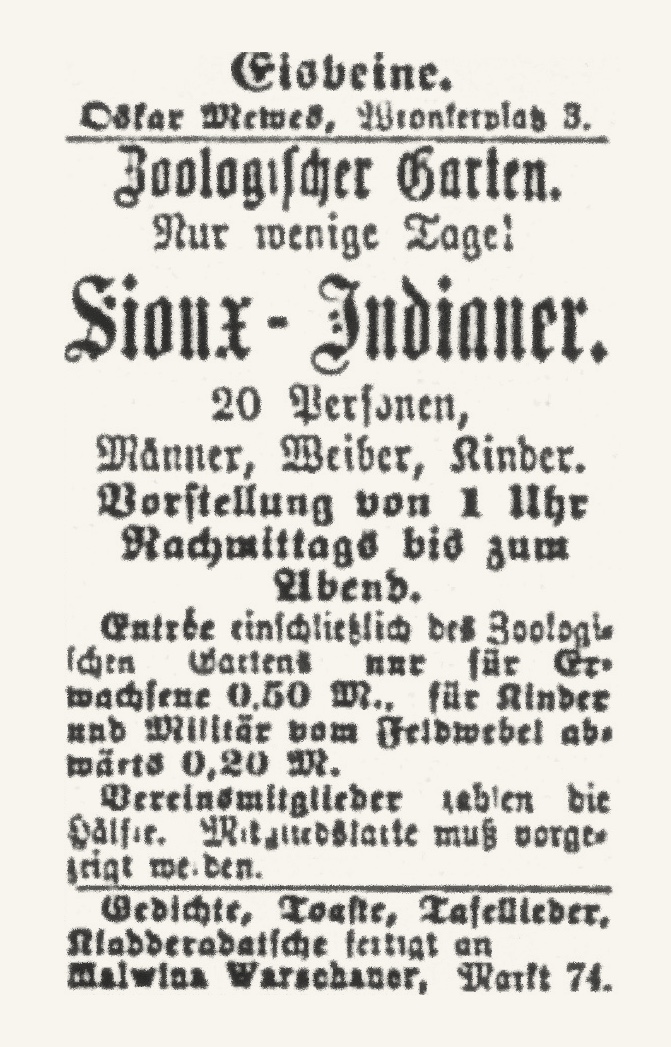BETWEEN VÖLKERSCHAU ENTERTAINMENT AND POPULAR EDUCATION
Although ethnographic shows were organised in many European countries, they were predominantly a German phenomenon. The immense popularity of Völkerschauen (shows of peoples) and the frequency with which they took place throughout German lands (including Prussia) stemmed from a number of different factors. The society of the newly reunited Germany (1871) was trying to redefine its identity in relation to both the outside world and the complex internal situation. In the nineteenth century, Imperial Germany adopted the so-called culture of progress, taking on technological challenges, establishing new institutions and engaging in scientific research on an unprecedented scale. One of the consequences of the new approach was the rapid development of the railway system: a direct railway connection between Berlin and Wrocław (Ger. Breslau) was completed in 1846; the one between Wrocław and Poznań (Ger. Posen), in 1856. The Prussian Eastern Railway linked Berlin with cities such as Gdańsk (Ger. Danzig) and Kaliningrad (Ger. Königsberg). The new institutions included universities and zoological gardens, which reflected the period’s optimism and faith in progress, science and popular education. At the same time, despite joining the colonial race relatively late, between the 1880s and the Great War Germany was actively involved in colonial expansion, gaining outposts in Africa and Oceania. (These overseas territories were later lost following the Treaty of Versailles.) Such was the context in which Carl Hagenbeck developed his Hamburg-based company, which would for several decades dominate the so-called ethnographic industry. He advertised his shows as Anthropologisch-zoologischen Schaustellungen (ethnographic and zoological exhibitions). Aside from Hagenbeck’s impresarios, ethnographic show organisers active in the eastern reaches of the German Empire included the brothers Carl and Fritz Marquardt.
The research conducted thus far indicates that ethnographic shows in the eastern regions of the Reich mainly took place in large urban centres such as Gdańsk, Kaliningrad, Wrocław, and Poznań. This is not to mean that ‘exotic’ Others never performed in smaller towns like Toruń (Ger. Thorn), Bielsko-Biała (Ger. Bielitz-Biala), or Świdnica (Ger. Schweidnitz). Due to Germany’s involvement in colonial expansion, the ethnographic shows organised in the Empire were a form of not only mass entertainment, but also popular education with a propagandistic and ideological undertone. They served as the means to boost popular support for the ‘German mission of civilisation’ in the colonies. As far as the eastern German provinces were concerned, such propaganda was not successful among the Polish population, who were experiencing an aggressive policy of Germanisation. Poles watched ethnographic shows and adopted many of the colonial ideas pertaining to non-European peoples, yet often used events of this kind to make motions they considered to be of import, for instance ones pertaining to the preservation of the Polish language.
“African village” at the East German Exhibition of Industry, Craft and Agriculture in Poznań, 1911. Source: Cyryl. The Virtual Museum of Poznań’s History. Roman Trojanowicz’s collection.
In cities that were part of the Second German Reich before the Great War, ethnographic shows were often part of major general, national and industrial exhibitions, in the form of ‘native villages’. The East German Exhibition in Poznań, held between May 15 and September 30, 1911, aimed to present the accomplishments of the German ‘mission of civilisation’ in the east. Since the entire enterprise was decidedly nationalist in tone, Poles boycotted the exhibition. The “African village” inhabited by several dozen non-European people—with huts, a shop, merchant workshops and a mosque—was one of the main attractions intended to provide the audience with additional entertainment. The main objective was, however, very different. The display advertised as the “African village” was meant to present and promote the German acquisitions in Africa. Since a prohibition against recruiting natives from German colonies to ethnographic troupes was introduced in 1901, the organisation of the “African village” required a special permit. The propagandistic message of the exhibition was additionally reinforced by the presence of the so-called Kleinsiedlungsdorf (model settlement). By providing visitors with the opportunity to compare the “African village” and the model German settlement, the organisers of the exhibition wished to accentuate the civilisational superiority Germans held over the peoples they had colonised, and to present the German ‘mission of civilisation’ in a positive light. This mission was also to be implemented in the eastern borderlands of the German Empire, with the support of the Settlement Commission.
Crowds at the entrance to the Bedouin ethnographic shows, Wrocław zoo, 1912. Source: Archive of the Zoological Garden in Wrocław.
Covers of the Zoologischer Garten illustrated magazine, published by the zoological garden in Wrocław. Both issues were dedicated entirely to ethnographic shows: issue no. 23 from 1906 focused on the “African village”; issue no. 42 from 1909 on the “Sudanese village”. Source: Archive of the Zoological Garden in Wrocław.
The zoological garden in Wrocław opened in 1865. Wrocław was the eighth city in the German Reich to feature such an institution. Research conducted thus far suggests that between 1876 and 1930 the Wrocław zoo organised over twenty ethnographic shows involving troupes from many parts of the world: for example Samoyeds, Ashanti peoples, Samoans, Bedouins, Tunisians and others. The performances staged at the zoological garden were widely popular. The Nubian show presented in 1876, for instance, gathered an audience of over 30,000 on the first day alone; a Tunisian troupe performing in 1904 managed to attract 41,509 spectators in only one day (July 3); and the total number of tickets sold for the Samoan performance in 1910 was 105,304. There were many reasons for the popularity these shows enjoyed in Wrocław and other urban centres of the German Reich, including the Industrial and Scientific Revolution, processes of identity building, and colonial rivalry.
The Dinka group at the Poznań exhibition of the Tribes of the Nile Valley. Source: Archive of the Zoological Garden in Poznań, an excerpt from Ostdeutsches Sonntagsblatt, August 19, 1914.
The Bishari group at the Poznań exhibition of the Tribes of the Nile Valley. Source: Archive of the Zoological Garden in Poznań, an excerpt from Ostdeutsches Sonntagsblatt, August 19, 1914.
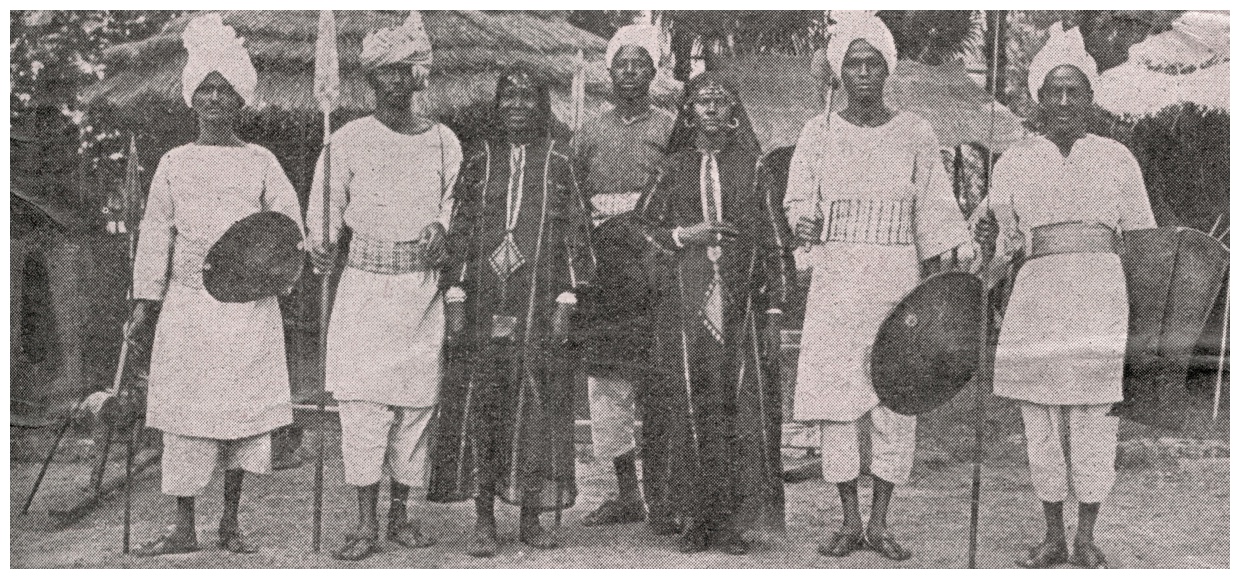
The Berabra group at the Poznań exhibition of the Tribes of the Nile Valley. Source: Archive of the Zoological Garden in Poznań, an excerpt from Ostdeutsches Sonntagsblatt, August 19, 1914.
At least several tribal (for example Berabra, Bishari, Bari, Bedaria, Madi, Nuba, Dinka) and professional groups (for example Fellahin peasants from Egypt) performed at ethnographic shows organised by Carl Marquardt in 1914. German-language press in Wrocław and Poznań referred to it as an exhibition of the Nile Valley Tribes, the Human Races of the Nile Valley (Die Menschenrassen des Niltals), the Peoples of the Nile Valley (Die Voelker des Niltals), or the Negro Races of the Nile Valley (Die Negerrassen des Niltals). The show was presented to audiences in many European countries, Germany being no exception. The show made an appearance at the zoological garden in Poznań (July 10–23) and in Wrocław (July 31–August 23). In the latter case, the troupe arrived shortly after the outbreak of the Great War (July 28). The 1914 exhibition followed a different model than the earlier ethnographic shows, presenting not one, but many groups inhabiting the same geographical region, juxtaposing nomadic peoples with agricultural communities. This decision was inspired by two hypotheses pertaining to race that appeared in nineteenth-century academia. The first of these claims was that “skin colour changes with latitude”; the second was that “there are various forms of adaptation to social conditions”. The juxtaposition presented in the show illustrated the differences in both skin colour and adaptation to the environment (the audience could see, for instance the tools and the animals characteristic of a given economic model). The exhibition was meant as a source of information on the human body, a form of accentuating cultural as well as ‘racial’ boundaries, and—lastly—as a challenge for the audiences’ sense of homogeneity. The programme of the exhibition of the Tribes of the Nile Valley in Poznań and Wrocław was a means of presenting ‘exotic’ peoples in a ‘scientific’ manner.
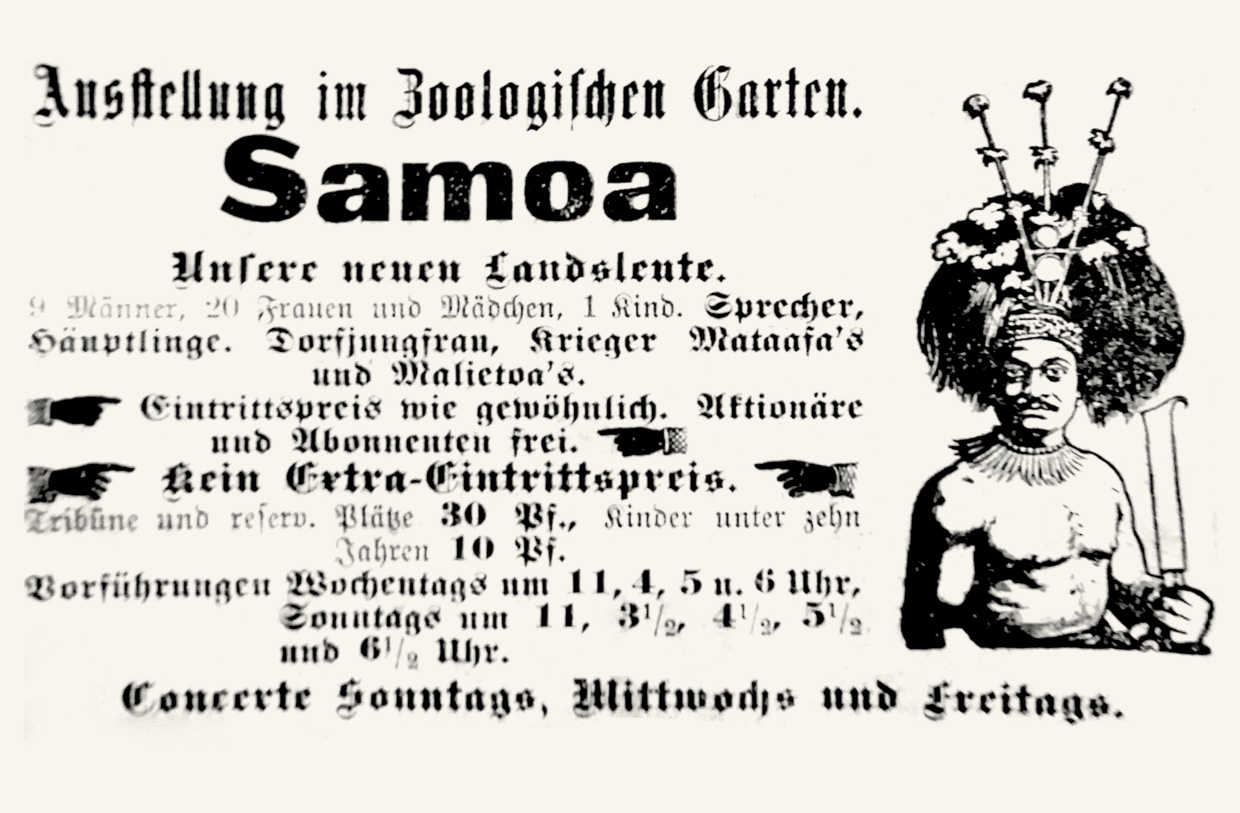
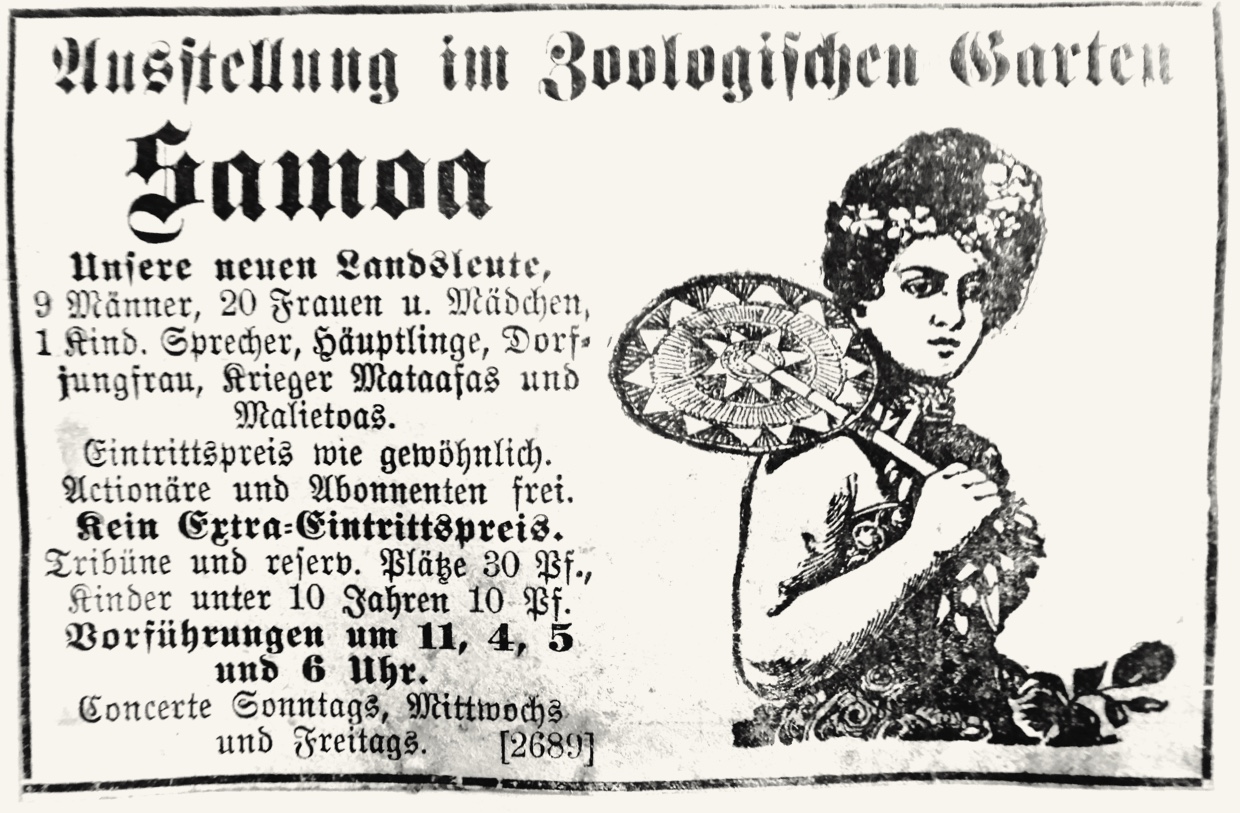
Advertisements for the Samoa show at Wrocław zoo. Source: Breslauer Zeitung, September 1, 1900.
As in other regions of the German Empire, ethnographic shows visiting Prussian cities were presented by their impresarios as an educational experience. Human live displays were further legitimised by the presence of scholars. The Wrocław zoological garden often held private shows for members of the academic community, usually before the ‘exotic’ troupe was given the opportunity to perform for the general public. One such special performance, which also had propagandistic overtones, took place in 1900, when the garden was visited by a troupe of Samoan peoples (August 21–September 16) managed by Carl and Fritz Marquardt. As reported in the German-language press, a Samoan man named Te’o Tuvale made an official speech during this special show. In this address, which was being interpreted into German by Fritz Marquard, Tuvale allegedly extended greetings to the Emperor and the gathered crowd, and made assurances of the Samoans’ loyalty to Germany. The choice of Tuvale as the one to make the speech was hardly accidental. The Samoan was a local politician from a privileged family, who entered the colonial service in Samoa and held positions of power under different colonial governments until the end of his days.
Reports from the ethnographic shows held in Poznań were published simultaneously in the German- and Polish-language press. A comparison of these articles reveals that many descriptions published in the German-language material (especially pertaining to the appearance or lifestyle of ethnic groups) appeared in Polish-language titles in a nearly unchanged form. However, the Polish-language press emphasised certain elements that were unquestionably related to the political and cultural situations of Poles in East Prussia. It also disregarded those aspects of the organisation of the ethnographic show that referred to the Emperor or to German authority. For instance, during the “Nubian caravan’s” stay in Poznań in 1879 periodicals published in Polish made no mention of the fact that members of the troupe paraded in front of Emperor Wilhelm’s statue, an episode which the German-language press discussed at length. Despite the coordinated policy of Germanisation, ethnographic shows provided Poles with the opportunity to postulate for the preservation of the Polish language, both in terms of its usage (for instance in printed advertisements) and calls for grammatical correctness.
The director of the Wrocław zoological garden, Friedrich Grabowski, and children from Samoa, 1910. Source: Archive of the Zoological Garden in Wrocław.
The director and an employee of the Poznań zoological garden with an elephant and its caretaker from the Sinhalese group, 1928. Source: Archive of the Zoological Garden in Poznań.
Non-European peoples and their exotic animals fascinated not only the press and the academic community. Directors of zoological gardens and members of local elites were also eager to be photographed with them.
Advertiesement for the “Shilluk village” in Bielsko-Biała. Source: Bielitz-Biala’er Anzeiger, August 7, 1899.
Ethnographic shows were a form of urban entertainment. Most performances took place in large cities, partly due to the fact that cities could ensure a large enough audience to generate profit. This does not mean that non-European troupes never visited smaller towns. This is apparent, for instance, from source material related to the Shilluk shows presented in Bielsko-Biała in 1899, or the Somali performance in Świdnica in 1911.

The “Somali village” at the Trade and Industry Exhibition in Schweidnitz (now Świdnica in Poland), 1911. Source: Collection Radauer.
The “Somali village” was a part of the Gewerbe- und Industrieausstellung (Trade and Industry Exhibition) in Świdnica. The exhibition, organised for the seventy-fifth anniversary of the Schweidnitz Trade and Craft Association, took place between May and September 1911 and was one of the largest events of this type in Lower Silesia. Frederick Wilhelm von Hohenzollern was present at the opening. Somali performances not only provided entertainment for the visitors, but also served a propagandistic function. The presentation of German products, new technologies and economic development against the backdrop of African tools, handiwork and crafting techniques was meant to accentuate the differences in the level of civilisation represented by Germany and the colonised peoples.
Advertisement for the Sioux show at the Zoological Garden in Poznań. Source: Posener Zeitung, April 20, 1884.
The analysis of press materials pertaining to ethnographic shows needs to be conducted with extreme care. In 1884 a German-language newspaper reported the death and burial of a Sioux chief:
Father Yellow Smoke, the old leader of the Sioux-Omaha tribe, has died in Posen and was buried by the members of his tribe, with large crowds in attendance, on foreign soil. He was taken by an internal illness. (Posener Zeitung, April 27, 1884)
Polish-language press from that time made no mention of the event. Interestingly, later in the tour, that same Native American troupe performed in Warsaw. Polish-language press in the city mentioned the chief a number of times, referring to him as a living member of the group: “One of such indigenous chiefs (Yellow Smoke) is among the individuals currently presenting themselves in Warsaw” (Kurier Warszawski, May 15, 1884). Consequently, it is difficult to ascertain whether the information about the chief’s death was false, or perhaps some other member of the group started to play the chief for the purpose of the show. The latter seems probable, given the fact that, in the context of ethnographic shows, individuals were much less important than the characters they portrayed.
![]()
Credits:
Dagnosław Demski, Institute of Archaeology and Ethnology, Polish Academy of Sciences; Dominika Czarnecka, Institute of Archaeology and Ethnology, Polish Academy of Sciences

